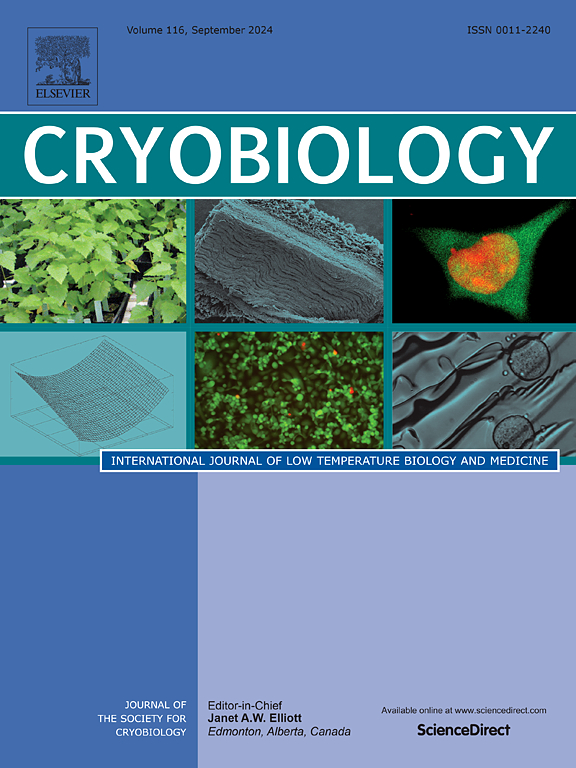氧化胁迫对冷冻保存前后不同含水量的芍药种子活力变化的影响
IF 2.1
3区 生物学
Q2 BIOLOGY
引用次数: 0
摘要
在液氮(LN)中冷冻保存是一种有效的种子长期保存策略,而含水量是影响冷冻保存后种子存活率的主要因素之一。本研究以不同含水量的芍药种子为材料,测定低温保存前后抗氧化系统的变化。当白芍药种子的含水量为 15.96% - 10.12% 时,白芍药种子的存活率与未冷冻保存的种子相比明显下降,但在含水量为 8.14% - 7.56% 时则无明显差异。然而,当乳花种子的含水量降至 6.01% - 5.19% 时,其存活率与未冷冻保存的种子相比略有提高。高含水量(15.96% - 10.12%)种子的超氧阴离子(O2-)、羟自由基(-OH)、过氧化氢(H2O2)、丙二醛(MDA)和蛋白质羰基(PCO)含量在低温保存后显著增加。然而,在低含水量(6.01% - 5.19%)的种子中,超氧阴离子(O2-)、羟自由基(-OH)和过氧化氢(H2O2)在低温保存后没有明显变化,而氧化应激指数 MDA 和 PCO 则有所下降。这三种物质与种子活力呈明显的负相关。在抗氧化物质方面,含水量不同的种子在低温贮藏过程中,过氧化氢酶(CAT)、抗坏血酸(AsA)和谷胱甘肽(GSH)的含量降低,谷胱甘肽还原酶(GR)和脱氢抗坏血酸还原酶(DHAR)的活性升高。这些变化与 ROS 含量以及 MDA 和 PCO 的变化明显相关,其中 AsA 含量、GSH 含量和 CAT 活性与种子活力呈正相关。GR 和 DHAR 活性的变化与种子活力呈负相关。综上所述,当种子含水量在 8.14% - 5.19% 之间时,冷冻保存后 ROS 含量与保存前相比没有显著增加。从低温保存前后 MDA 和 PCO 含量的变化可以推断,种子没有发生明显的氧化损伤,因此种子的活力与低温保存前相比没有下降。因此,冷冻保存乳果树种子的最佳含水量为 8.14% - 5.19%。本文章由计算机程序翻译,如有差异,请以英文原文为准。
Effects of oxidative stress on the changes of viability of Paeonia lactiflora seeds with different water content before and after cryopreservation
Cryopreservation in liquid nitrogen (LN) is an efficient long - term seed preservation strategy and water content is one of the main factors affecting seed viability after cryopreservation. In this study, Paeonia lactiflora seeds with varying water content were used as materials to determine changes in the antioxidant system before and after cryopreservation. When the water content of P. lactiflora seeds was 15.96 %–10.12 %, the viability of P. lactiflora seeds decreased significantly compared with that of the seeds without cryopreservation, but at the water content of 8.14 %–7.56 % there were no significant differences. However, when the water content of P. lactiflora seeds decreased to 6.01 %–5.19 % the viability was slightly increased compared to the seeds without cryopreservation. The content of superoxide anion (O2−), hydroxyl radical (·OH), hydrogen peroxide (H2O2), malondialdehyde (MDA) and protein carbonyl group (PCO) of seeds with high water content (15.96 %–10.12 %) were significantly increased after cryopreservation. However, superoxide anion (O2−), hydroxyl radical (·OH) and hydrogen peroxide (H2O2) did not change significantly in seeds with low water content (6.01 %–5.19 %) after cryopreservation, while oxidative stress indexes MDA and PCO decreased. These three substances were significantly negatively correlated with seed viability. In terms of antioxidant substances, the contents of catalase (CAT), ascorbic acid (AsA) and glutathione (GSH) decreased and the activities of glutathione reductase (GR) and dehydroascorbate reductase (DHAR) increased during the cryopreserved process of seeds with varying water content. These changes were significantly correlated with ROS content and the changes of MDA and PCO, among which AsA content, GSH content and CAT activity were positively correlated with seed viability. The changes of GR and DHAR activity were negatively correlated with seed viability. In summary, when the water content of the seeds ranged from 8.14 % to 5.19 %, ROS content did not increase significantly after cryopreservation compared with that of before preservation. The changes of MDA and PCO contents before and after cryopreservation, it was inferred that no obvious oxidative damage occurred in seeds, so the viability of seeds did not decrease compared with that of before cryopreservation. Therefore, the optimum water content of P. lactiflora seeds for cryopreservation is 8.14 %–5.19 %.
求助全文
通过发布文献求助,成功后即可免费获取论文全文。
去求助
来源期刊

Cryobiology
生物-生理学
CiteScore
5.40
自引率
7.40%
发文量
71
审稿时长
56 days
期刊介绍:
Cryobiology: International Journal of Low Temperature Biology and Medicine publishes research articles on all aspects of low temperature biology and medicine.
Research Areas include:
• Cryoprotective additives and their pharmacological actions
• Cryosurgery
• Freeze-drying
• Freezing
• Frost hardiness in plants
• Hibernation
• Hypothermia
• Medical applications of reduced temperature
• Perfusion of organs
• All pertinent methodologies
Cryobiology is the official journal of the Society for Cryobiology.
 求助内容:
求助内容: 应助结果提醒方式:
应助结果提醒方式:


